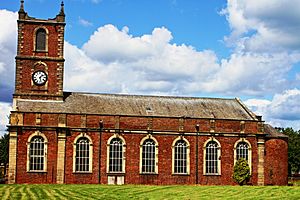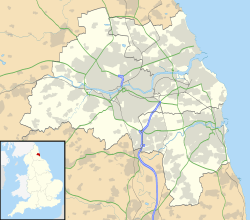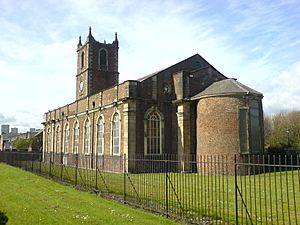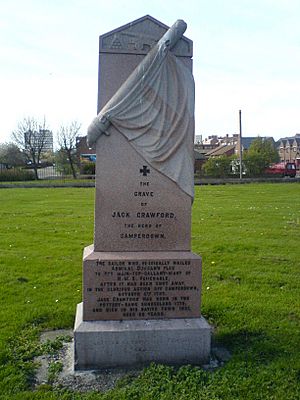Holy Trinity Church, Sunderland facts for kids
Quick facts for kids Holy Trinity Church |
|
|---|---|
| Sunderland Parish Church | |
 |
|
| 54°54′28″N 1°22′07″W / 54.907765°N 1.368648°W | |
| OS grid reference | NZ 40575 57189 |
| Location | Church Street East, Sunderland, Tyne and Wear SR1 2BJ |
| Country | United Kingdom |
| Denomination | Anglican |
| History | |
| Status | Parish Church |
| Founded | 1719 |
| Dedication | The Holy Trinity |
| Consecrated | 5 September 1719 |
| Architecture | |
| Functional status | Preserved |
| Heritage designation | Grade I listed |
| Designated | 8 May 1950 |
| Style | Baroque |
| Years built | 1718–1719 |
| Groundbreaking | 1718 |
| Administration | |
| Parish | Sunderland |
| Diocese | Durham |
The Holy Trinity Church is an Anglican church building in Sunderland. It was once the main church for the area. It opened in 1719 and served the local community for many years. However, fewer people attended over time, and it closed in 1988. Today, the Churches Conservation Trust looks after it. They have turned it into a place for community events and culture.
Contents
History of Holy Trinity Church
Why a New Church Was Needed
In 1712, the port of Sunderland was growing very fast. The old church, St. Michael's, was becoming too small. It couldn't serve all the new people moving to the area.
Some local business owners decided to help. They started a plan to build a new church. They chose a spot on the town moor in the east end of the city.
Because of the fast growth, a new church area, called a parish, was also needed. On March 9, 1719, a special law was passed by Parliament. This law created the Parish of Sunderland. That's why the church is sometimes called Sunderland Parish Church.
Church Design and Style
We don't know for sure who designed the original church. Some reports mention William Eddy, a local architect. Daniel Newcombe, who became the church's first rector, was also likely involved.
The church is built in the Baroque style. It's made of brick with stone details around the doors and windows. The first building didn't have a rounded end section (called an apse). This was added later.
Inside, the church was described as "handsome." The rows of seats (pews) were separated from the main area (nave) by seven pillars on each side. These pillars had fancy tops called Corinthian capitals. There were also galleries (balconies) on the sides and at the back.
Opening the Church Doors
Work on the church started in 1718. The building was finished quickly, and on September 5, 1719, it was officially opened. Before that, on June 2, 1719, the first wedding took place there. Jonathan Chambers and Elizabeth Hutchinson were the first couple to get married in the new church.
Changes in the 1700s
In 1735, Daniel Newcombe, the church's rector, decided to add an apse to the eastern end. This addition gave the church a chancel, which is the area around the altar. The apse was large and almost circular, with a big Venetian-style window. This part of the building is still there today. Newcombe paid for this extension himself.
The 1800s and Important Additions
The church got a new roof in 1803. The roof was raised to make space for a new gallery. The windows were also replaced that same year.
In 1854, the last person was buried in the church graveyard.
A beautiful stained-glass window was added to the east side in 1857. It was made by James Hartley's glassworks in Sunderland. This window shows the Ascension, which is a religious scene.
The Story of Jack Crawford
Jack Crawford was known as the "Hero of Camperdown." He was a sailor on a ship called HMS Venerable in 1797. During the Battle of Camperdown, his ship was hit. The mast was damaged, and the admiral's flag fell down. This looked like the ship was giving up!
But Jack Crawford was brave. He climbed the broken mast and nailed the flag back to the top. This showed that the ship was still fighting.
People in Sunderland celebrated Jack for his heroism. They even gave him a silver star. However, he later became poor and died in 1831 from a cholera outbreak.
In 1888, Holy Trinity Church put up a headstone in its graveyard to honor him. It reads: "The sailor who heroically nailed Admiral Duncan's flag to the main-top-callant-mast of H.M.S. Venerable, after it had been shot away, in the glorious action off Camperdown, October 11th 1797. Jack Crawford was born in the pottery-bank Sunderland 1775, and died in his native town 1831, aged 56 years." Two years later, a statue of him was placed in Mowbray Park.
The 1900s and Closure
The church's windows were replaced again in the early 1900s. However, as the century went on, fewer and fewer people attended church in Sunderland's east end.
The number of churchgoers kept getting smaller. Finally, on June 26, 1988, the church had to close. It was then given to the Redundant Churches Fund, which is now called the Churches Conservation Trust. The building needed a lot of expensive repairs, and the Trust is still working on them today.
The old caretaker's cottage next to the church, which used to be the Donnison School, became a heritage and education center in 2007.
Holy Trinity Church Today
Holy Trinity Church is no longer used for church services. Today, the building is known as Seventeen Nineteen. It serves as a community space and a center for arts and culture.






